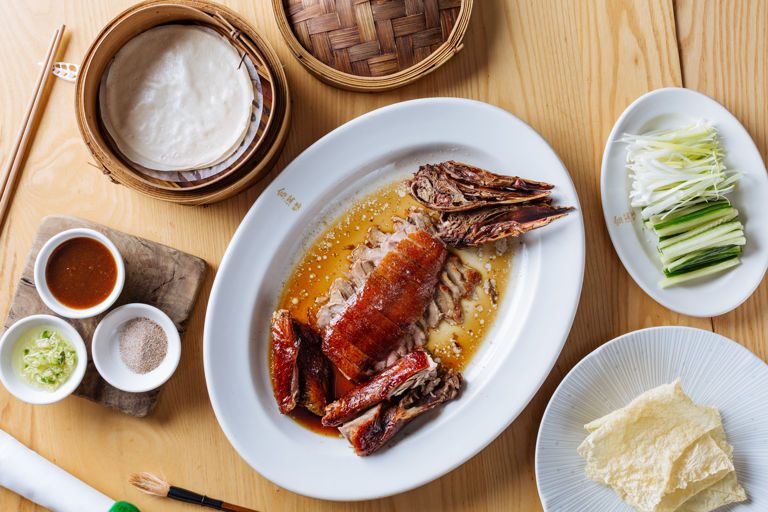Peking duck
Item 1 of 1
- 6
- 3 hours
Andrew Wong's Peking duck recipe is not a dish to commit to lightly. But this Chinese classic, which Andrew has dedicated years of research to, possesses flawlessly crispy, glassy skin that is more than worth it if you have the patience. An electric bike pump and fan are needed so prepare yourself well before you start!
First published in 2017
discover more:
Ingredients
Metric
Imperial
Peking duck
- 1 whole frozen duck, about 2.6kg in weight (Andrew uses ducks from Silver Hill farm)
- 2 tbsp of sugar
Five-spice salt
- 100g of Chinese five-spice powder
- 50g of salt
Maltose syrup
- 2 tbsp of Shaoxing wine
- 2 tbsp of Chinese red vinegar
- 3 tbsp of maltose
To serve
- 12 Chinese pancakes
- 1 bunch of spring onions, finely sliced
- 1 cucumber, finely sliced
- hoisin sauce, or plum sauce
SAVE RECIPE
Equipment
- Bicycle pump
- Electric fan
- Meat hook
Method
1
On day one, defrost the duck and rinse well with cold water
- 1 whole frozen duck, about 2.6kg in weight (Andrew uses ducks from Silver Hill farm)
2
Make the five-spice salt by mixing together the five-spice powder and the salt
- 50g of salt
- 100g of Chinese five-spice powder
3
Using an electric bike pump, insert the end of the pump just under the skin, entering from the bottom of the belly. When done correctly, the entire bird will begin to inflate as the air travels in-between the flesh and the skin of the duck
4
Add 2 tbsp of the five-spice salt to a bowl and mix with the sugar. Use the mixture to season the inside of the duck
- 2 tbsp of sugar
5
Insert a hook into the back of the bird and hang it up over the draining board in the kitchen to dry for 10 minutes
6
Bring a large pan of water to a rolling boil. With the duck held over the pan, use a large ladle or small saucepan to pour the boiling water all over the skin of the duck, letting it fall back into the pan. Continue pouring the water over the duck until every inch of skin has had a good dousing – you will see the skin tighten up and change colour slightly
7
Hang the duck in a cool, dry place for 30 minutes
8
For the maltose syrup, bring all the ingredients to the boil in a large pan with 500ml of water
- 2 tbsp of Shaoxing wine
- 3 tbsp of maltose
- 2 tbsp of Chinese red vinegar
9
Pour the boiling syrup repeatedly over the skin of the duck as you did with the boiling water in step 5
10
Hang the duck in a cool, dry place for 12–24 hours to dry out, placing an electric fan in front of the bird to accelerate the process
11
On day two, check the duck to see if it is ready for roasting – the skin should be completely dry to touch. If so, preheat the oven to 120°C/gas mark 1/2
12
The idea is to hang the duck by the hook from the top shelf in the oven to roast, with the door slightly ajar, for 1 hour. However, it is probable that your oven isn't big enough to hold a hanging duck! In this case, aim to get the back skin to restaurant quality, which is a lot easier to bring to glass-like perfection anyway. Place the duck breast-side down on a rack set over a roasting tray and roast as above
13
After 1 hour, turn the oven up to 200°C/gas mark 6 and roast for a further 15 minutes with the door very slightly ajar to allow any condensation to escape. Note that different ovens may vary in temperature once the door is open, so if you have a temperature probe ensure the duck is fully cooked after this time; it may need a few minutes more
14
Remove the duck from the oven and immediately start taking off the hard, lacquered skin, as the longer you leave it attached, the more likely the steam generated from the flesh will soften it into a limp, soft mess
15
Remove the duck meat from the carcass and thinly slice, then serve with the skin, pancakes, crunchy veg and sauce
- hoisin sauce, or plum sauce
- 12 Chinese pancakes
- 1 bunch of spring onions, finely sliced
- 1 cucumber, finely sliced
Get in touch
Please sign in or register to send a comment to Great British Chefs.



